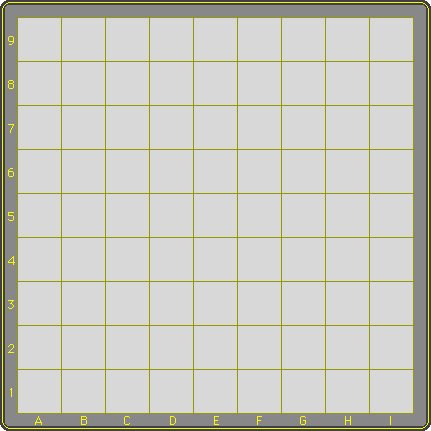 |
Rules There are two players, Black and White. Each has a sufficient number of stones and both move only with their own colour. Capture Io features 'othelloanian capture'. Generally speaking it means that if a placement results in one or more opponent's stones that lie in an unbroken straight or diagonal line, to be enclosed between the placed stone and a like colored stone at the other end, then these stones are captured and reversed in the same turn, to reveal the moving player's color. The diagram shows a 9x9 board. Beginners may benefit from using an Othello board (8x8) or smaller. |
The one-bound-one-free phase
White starts by placing one stone on the empty board, but not on a corner. From that point on players take turns to:
- Place a stone on a cell straight or diagonally adjacent to the last stone placed by the opponent, and ...
- ... place a stone on a on a cell that has only vacant cells, straight and diagonally, as neighbours.
- In this phase a corner may only be occupied with the first or bound placement.
- Both placements are compulsory. When the player to move can no longer make the second placement, then his turn ends and his opponent may start the single placement phase.
Note: the diagram shows a board position at the end of the first phase. White's last free move was at C1. Black's bound reply was at B2 to keep E1 for free placement. Thus White is forced to make a bound move (F2) and leave the first move in the next phase to Black. If Black had chosen D1 or D2 for his bound placement, there would have been no place for a free placement, and White would have had the first move of the next phase.
Capture in the one-bound-one-free phase
By the nature of the protocol, capture with a free move is not possible. Capture with a bound move follows the normal othelloanian protocol. Because of captures, the number of stones of each color may not be the same at the end of this phase, though the number of placements of both sides will always be the same.
The single placement phase
Now players take turns to compulsory place one of their stones on any vacant square. Corners are no longer excluded. If a placement results in capture, then the normal othelloanian protocol is followed.
Object
The game ends when the board is full. Winner is the player with the most stones. Draws are not possible.
Play Io interactively
How I invented … Io
External links
About Io
Sometimes I find games by accident. I suddenly saw that the one-bound-one-free opening protocol would serve perfectly to rid Othello of its rigid mechanical move protocol, and would result result in a much freer and more organic game. The protocol inherently serves as a turn order balancing mechanism. Even if one could establish some theoretical advantage for say the first player to move after the entering stage, which seems unlikely to begin with, then it would still be up to the players to try and become that player.
Io is much better than Othello. It has neither Othello like compulsory capture, nor compulsory passes. Where in Othello Black and White face different subsets of the vacant squares for legal placement, with an occasional square available to both, in Io all vacant squares are always accessible for both. Having to consider a square not only for placement, but also for placement by the opponent, already makes a big difference. In Io squares may be tempting for both, or inaccessible for both on tactcal grounds, or 'miai', where two squares have a relationship in which the taking of one by one player must be answered by the taking of the other by the opponent. Io is drawless and inherently balanced. In its free placement stage the considerations, both strategical and tactical, are more varied and intricate than those Othello can provide. In the entering stage these considerations must of course merge with the requirements of the protocol, which leads to specific dilemmas.
The game uses an odd sized board, say 7x7 or 9x9, to prevent draws, but an 8x8 game is entirely possible, so with an Othello set you can check out the game for yourself.
An example game
|
|||||||||||
Io © MindSports



